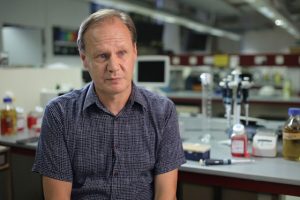Genetics and Education
Neuroscientist Michael Thomas on the heritability of intelligence, the predictive power of the DNA, and a redu...
The video is a part of the project British Scientists produced in collaboration between Serious Science and the British Council.
The diabetes is a cluster of metabolic conditions all characterized by hypoglycemia, or raised blood glucose levels. This occurs in the face of absolute or relative insulin deficiency. Insulin is the key hormone secreted by the pancreas that modifies the glucose levels in the blood. And glucose has to be kept within a very tight range: too high – and we get complications related to the metabolic effects of glucose particularly in the small vessels of the body (the eyes, the feet) and also the large vessels like the heart itself. Too low – and we get problems of low glucose related to problems in the brain. So it’s kept in a very tight homeostatic range. When this gets out of control to the high level that is what the problem of diabetes is.
Now, until the early part of the 20th century, all diabetes was considered to be the same. In fact, it comes from a Greek word meaning – diabetes means the siphon. That term is used because it characterized by excess of urine and too much water flowing out of the body as a consequence of the high glucose levels. And the other word is ‘mellitus’ meaning sweet. So, originally the diagnosis was made by characterizing the urine as tasting sweet, because glucose was lost in the urine. And in the early part of the 20th century, our understanding of diabetes changed, when insulin was discovered by Banting and Best in Canada, for which they won the Nobel Prize.
Shortly afterwards it became possible to measure insulin and thereafter it was possible to distinguish between people who had a form of insulin deficiency which gave rise to diabetes as opposed to another group of people who had very high levels of insulin and appeared to be resistant to its effects. This led to a distinction between type 1 diabetes, which is a disorder that characteristically comes on in young people, has an acute onset and is due to absolute deficiency of insulin by the pancreas. And the other form of diabetes, to which we give the label type 2 diabetes, which tends to me more insidious, comes on slowly in mid- or late life, and is associated with relative deficiency of insulin, but absolute problems of insulin resistance at the end organs and those organs are the skeletal muscle, the adipose tissue, and the liver.
Now, if you take a step back from that clinical perspective and try and place diabetes in a global perspective, there are some 400 million people with diabetes around the world. 80% of them live in low and middle-income countries. These are countries with poor availability of healthcare systems. I think globally we’ve got a major challenge, because in addition to those 400 million people, there’s something like half a billion people who are at risk of diabetes. So, there’s a major scientific challenge about where we put our priorities, how we improve systems of care for the people who have the condition now, and ensure that people around the world have access to simple efficacious therapies, and also how we put in place systems for screening and prevention of diabetes on the population level.
We also have to invest in trying to improve diabetes care. That’s in two ways: we have to get better systems of care, because the real cornerstone of therapy is to have registers of people with diabetes to ensure that people are recalled annually to have checks of simple parameters: to determine who’s at risk, to measure their blood pressure, their cholesterol and to measure of their hyperglycemia with the HBA1C, and then to act to keep those in check, and also to check for the presence of complications by examination of the evidence of peripheral neuropathy on their feet, examination of the retina to detect diabetic retinopathy. By putting in place systems of care we know that that can result in improved outcomes.
In conjunction with that, however, we have to continually seek to try and try and get better therapies. One of the problems with diabetes is that we have some therapies metformin, sulfonylurea agents, GLP-1 agonist, other classes of drugs. Individually they’re not very effective and we have to search to find newer therapies that can reduce the blood glucose and ideally not result in weight gain at the same time.
In the past, the diagnosis of diabetes classically was based on a wall glucose tolerance test. This is a challenge test: the patient comes along fasted, having had an overnight fast and then they’re given blood sample of fasting and then given a challenge of 75 grams of anhydrous glucose in a drink and the blood glucose is then measured again at two hours. The criteria for diabetes were based both on the fasting and the two-hour blood samples. These were the classical ways of diagnosing diabetes and were used predominantly in epidemiological studies to define the prevalence of diagnosed and undiagnosed diabetes. The challenge was that that wasn’t used very much in clinical practice, because it’s a laborious time-consuming test, the person has to come along in a specialized state and they have to stay for the whole morning to have the test.
So, there was a big gulf between what was used in epidemiology and science from what was used in clinical practice. Particularly for the making the diagnosis in the asymptomatic individual. If somebody who has symptoms, it’s easy to make the diagnosis of diabetes. But as we focus our attention more on people who were asymptomatic, this gulf between clinical practice and scientific practice got wider and wider.
The HBA1C is another test that has recently been adopted for the diagnosis of diabetes. Glycosylated hemoglobin is a way of measuring an integrated sum of somebody’s glucose levels for the preceding two months. Hemoglobin levels get affected by ambient glucose levels in the blood, and as red cells live for 120 days, the proportion of a hemoglobin that’s in the form A1C, which is glycosylated, is in average indicator of what the glucose levels have been for the preceding two months. This measure is a good indicator of how somebody has been controlling their diabetes, it’s a good measure of how they respond to therapy and it predicts complications.
So, in the early part of the 2000s it became evident that this was a measure that could be used for the diagnosis of diabetes. This was originally proposed by the American Diabetes Association and then adopted by the World Health Organization.
If one looks around the world at the prevalence of diabetes, you see a marked variation between populations. It is very common in certain ethnic groups who have undergone rapid industrialization and westernization, particularly common in some Native American people and in South Pacific populations. It’s also extremely rare in some other populations. This has given rise to hypotheses about why type 2 diabetes might originate. One of those hypotheses is called the thrifty genotype hypothesis, which suggests that some populations (particularly those that have had periods of food scarcity and food abundance) have been enriched with a gene that might give rise to a survival advantage in the times of food scarcity, but then might become detrimental in the times of food abundance. The idea is that that gene, which would be thrifty and allow you to conserve energy very efficiently, would be then detrimental in times of wide food availability. So, this thrifty genotype hypothesis has been around for 50 years. The big question that is unanswered is – what is the molecular basis for this? Because we have no direct evidence of any genes that interact in this way that give rise to susceptibility to diabetes that only becomes manifest under certain environmental circumstances. Really finding that, if it exists, is a major challenge.

Neuroscientist Michael Thomas on the heritability of intelligence, the predictive power of the DNA, and a redu...

Scientists found a surprising lack of evolution that supports Darwin ideas

Molecular Biologist Greg Towers on HIV discovery in San Francisco, antiviral drug therapy and current areas of...